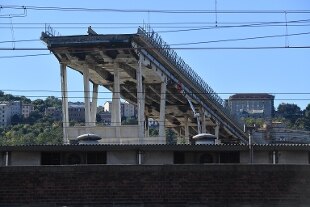The Morandi bridge on the A10 in Genoa collapses: 35 confirmed deaths
Ponte Morandi, two years after Genoa remembers the 43 victims of the collapse
Share
21 December 2020 "The results of the survey carried out show how the maintenance and conservation status of the part of the collapsed viaduct had a direct and clear influence on the collapse".
The experts write about the collapse of the Morandi Bridge in Genoa in their report for the investigating judge Angela Nutini.
"No factors independent of the state of maintenance and conservation of the bridge have been identified that may have contributed to the collapse", say the experts.
"Do not follow Morandi directions"
An extraordinary work for the time, but which needed special precautions which, however, were not followed.
This is what emerges from the report on the causes of the collapse of the Morandi bridge, a document requested as part of the second probative incident on the disaster of 14 August 2018, which cost the lives of 43 people.
According to the experts, the indications of the engineer Morandi himself have been neglected over the years, with particular reference to the degradation of the steel of the tie rods.
"The designer had paid attention to the risk of corrosion of the cables - highlight the experts of the investigating judge - These recommendations were particularly important and relevant considering the extraordinary nature of the work".
The experts found a "failure to perform specific investigations necessary to verify the state of the strands of the primary groups, as recommended since 1985".
Controls and maintenance interventions, "if they had been carried out correctly, with high probability they would have prevented the occurrence of the event. The lack and / or inadequacy of the controls and the consequent corrective actions constitute the weak links in the system; if they are missing, , had been carried out and, if carried out, they had been correctly, they would have interrupted the causal chain and the event would not have occurred ", the experts write.
"The root causes" of the collapse, the experts write, "can be identified in: design deficiencies, which had not adequately taken into account the construction details, with reference to the difficulty of making castings in the presence of very low interferences; lack of specifications adequate techniques on cable sheaths and injection methods; construction defects in the construction phase, of which the experts have not found any trace in the analyzed documentation, these are defects that would have been clearly visible in the construction phase; deficiencies of the controls in construction phase by the construction management and testing commission during construction; failure to carry out specific investigations (localized demolitions at the ends of the tie rods) necessary to check the state of the strands of the primary groups, as it was recommended since 1985; no restoration or repair work, which should have
or be performed over time to repair the faulty tie rod ".
Since 1993, the date of the last maintenance intervention, "no interventions have been carried out that could stop the degradation process in progress and / or repair the defects present in the ends of the tie rods which, on the top of the South tie-Genoa side of the pile 9 were particularly serious "the experts of the investigating judge write again about the collapse of the Morandi bridge.
"The South tie-Genoa side of pile 9 showed an evident and very serious form of corrosion in the area of attack with the antenna. The corrosion of the primary cables took place in areas of cavities and non-injection formed in the construction of the bridge" .

